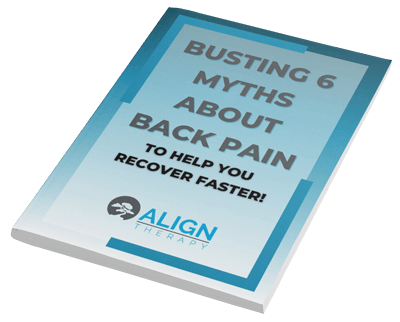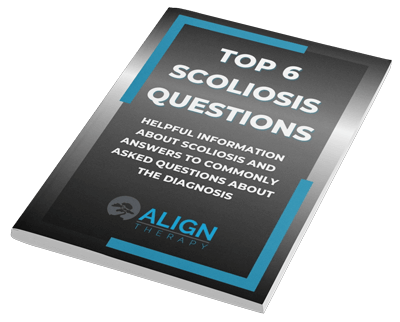Living with scoliosis doesn’t always mean you’re headed straight for surgery.
In fact, most adults with scoliosis—especially those diagnosed later in life—can benefit from natural, non-invasive methods that improve posture, support mobility, and reduce the daily challenges that come with spinal asymmetry.
That’s why I’m so passionate about sharing non-surgical scoliosis strategies. At Align Therapy, we help clients every day who feel unsure, overwhelmed, or frustrated by the information out there—and we offer practical, real-life tools that actually work.
Below are five of my top recommended approaches for adults with scoliosis looking to feel more balanced and in control—no surgery required.
1. Posture Awareness and Alignment Training
Scoliosis often causes the spine to curve in ways that disrupt the body’s natural alignment. Over time, this can lead to uneven pressure, fatigue, and limited movement. The first step in any non-surgical scoliosis strategy? Postural awareness.
Learning how to align your body—even in subtle ways—can make a significant difference. This includes:
- Using mirrors or video feedback to check your position
- Practicing gentle postural corrections while sitting or standing
- Avoiding positions that encourage one-sided leaning or slouching
Even a 10% improvement in posture can create better energy flow, reduced strain on muscles, and more confidence in movement.
2. Targeted Strengthening Exercises
A major focus in non-surgical scoliosis strategies is strengthening the muscles that support the spine.
This isn’t about bodybuilding—it’s about functional strength. We want to activate muscles that stabilize the spine, support upright posture, and help control movement through daily activities.
Some of the best scoliosis-friendly exercises include:
- Side-lying leg lifts (to strengthen the hips and core)
- Modified planks (for spinal support without excess strain)
- Resistance band pulls (for shoulder balance and posture)
The key here is balance. Many scoliosis curves cause one side of the body to work harder than the other. Custom strength programs can help even that out and reduce daily tension.
3. Breathing and Diaphragm Work
This is one most people overlook—but it’s incredibly important.
Scoliosis affects the structure of the ribcage and chest wall, which can alter how we breathe. Many people with scoliosis develop shallow breathing patterns or rely too much on one side of the body.
We use techniques based on the Schroth Method and other scoliosis-specific approaches to help patients retrain their breath, including:
- Side-shifted breathing (to expand the concave side of the curve)
- Core-connected exhalation (to improve spinal stability)
- Rib mobility drills (to reduce tightness and improve lung function)
Breath is more than relaxation—it’s about supporting your spine from the inside out. That’s a cornerstone of effective non-surgical scoliosis strategies.
4. Mobility and Flexibility Work
Tightness can make scoliosis feel worse—especially if one side of your spine or hips is constantly pulling against the other.
Improving flexibility in a scoliosis-friendly way helps reduce that tug-of-war. But not all stretching is created equal. In fact, certain stretches might make things worse if they aren’t tailored to your curve type.
We typically focus on:
- Dynamic stretches that promote symmetry
- Gentle spinal elongation (like wall-supported reaches)
- Hip and shoulder mobility routines to reduce compensation patterns
Most importantly, this work feels good. Clients often tell me they feel taller, looser, and more aligned—without needing to force or push too hard.
5. Mind-Body Awareness and Daily Habit Tweaks
Scoliosis doesn’t just affect the body—it can impact confidence, energy, and even mood.
That’s why one of the most powerful non-surgical scoliosis strategies is education. When you understand what your body needs, and how to move through life more consciously, you feel empowered.
Some small but impactful daily changes include:
- Sitting with support (lumbar rolls or posture cushions)
- Avoiding one-shoulder carrying (swap to backpacks or even load distribution)
- Breaking up long periods of sitting with movement breaks
When we work with patients, we focus on building long-term habits—not just a temporary fix. And when people take ownership of their movement, posture, and choices, they start to feel better almost immediately.
The Bottom Line: There Are Always Options
Scoliosis looks different in every body. But one thing is always true: there is so much you can do to support your spine without surgery.
The most effective non-surgical scoliosis strategies are simple, sustainable, and tailored to your unique curve and lifestyle.
We’ve helped hundreds of people regain control and confidence using these exact approaches—and you can, too.
Want to Explore What’s Right for You?
If you’re ready to take the next step toward managing scoliosis naturally, let’s talk.
We offer free telephone consultations where we can discuss your challenges, your goals, and how Align Therapy can support you with a personalized strategy.
Click here or call (801) 980-0860 to schedule your free call today!
Don’t wait for things to get worse. Start improving the way you move, feel, and live—starting now.
More free resources:
Download one of our free reports – Adult Scoliosis Lehi, UT, Adult Scoliosis St George, UT – Align Therapy Clinic, Utah
Read our blog – Traveling with Scoliosis or Back Pain: 3 Tips to Help Reduce Pain While Flying
Read our blog – Strengthening the Core: A Key to Managing Scoliosis Naturally



